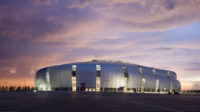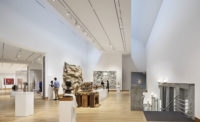Most of those thronging to the Metropolitan Opera’s new production of Massenet’s Werther this winter have gone to hear tenor Jonas Kaufmann’s mellifluous singing as the protagonist and the plush sounds of mezzo-soprano Sophie Koch as Charlotte. But some operagoers might also have appreciated the choreographic performance and efficiency of the set, which mechanically slides and shifts in different directions within the shallow space of the three-dimensional stage.
In recent years the Met has frequently explored the spatial dynamic of on-stage architectural elements to heighten dramatic action, most notably (and controversially) with Robert Lepage’s production of Wagner’s Ring Cycle in 2011 with its 90,000-pound rotating machinery (RECORD, March 2011, page 35). Such creative explorations show that the intricate play of two-dimensional and three-dimensional space based on static and active elements–even if confined by the proscenium–might make an uninitiated audience more susceptible to architectonic notions developed in the outside world.
Werther, directed by Richard Eyre with sets designed by Rob Howell, exploits the mobility of the stage design with fewer (and less scary) challenges than the Ring’s gigantic contraption. In developing the overall concept for Werther, Howell had his own motive: he had to create convincing surroundings where the romantic plot could unfold within the voluminous dimensions of the Met’s stage. “I was looking for a way to provide a picture but reduce the space so that the interaction between two human beings could occur,” he says.
The basic architectural device Howell developed is a series of large, rectangular frames of painted aluminum, diminishing in perspective as they retreat upstage. The rectilinear elements tilt up stage left in the first act and angle in the other direction in the second act. All the while they are separated from each other so that leafy tree branches pop through pergola-like openings for scenes at the Bailiff’s home and in the town square of the German village where the opera takes place. During a ballroom scene between the two acts, the floor plane is leveled. The thick rectangular frames come together to form tall paneled walls of a grand interior, where images of interior décor by video designer Wendell Harrington evanescently waft over the walls.
The third and fourth acts more dramatically emphasize the dimensional possibilities of the moving rectangles. In Charlotte’s drawing room, the frames become bookshelves receding enfilade; then at the end of the scene they quickly retreat laterally to signal a sudden shift in the mood of the drama. “Werther’s world starts exploding: we wanted to convey this with bookshelves that fly up and off stage at the same time,” says Howell, adding, “The scenery underpins that emotion.” By the fourth act, you see Werther at the end of his rope in his messy study—a small bright box seeming to levitate in the darkness upstage. Then it catapults forward, floating about four feet above the floor to skim over the furniture of the previous act. Guided by tracks, the mysteriously looming mise-en-scene again heightens the drama for the gloomy ending.
Since Eyre placed the period of the opera in the late 19th century, when Massenet lived, instead of the late 18th century of Goethe’s novel on which the opera is based, The Sorrows of Young Werther, the production’s costumes and furnishings had to be moved up a hundred years. Howell was inspired by the paintings of the Danish artist Vilhelm Hammershoi (1864-1916), whose spare, linear furniture and austere, monochromatic interiors have a haunting quality. If there is one disappointment in the set design, however, it would be that the actual furnishings don’t look austere and haunting enough: swag-like canopies and garden parasols in the first two acts do seem a bit too light and gemütlich, in a Pottery Barn sort of way, to fully complement the overall architecture of the framing elements. Nevertheless, the mobility of the architectural sets and the spatial dynamic created suggest a direction that should be pursued.








